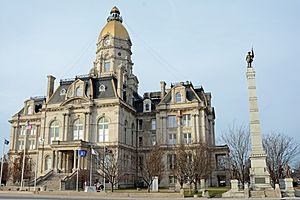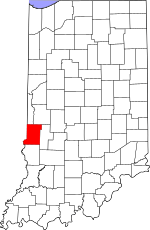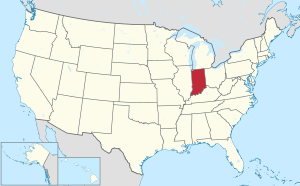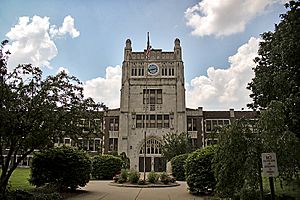Vigo County, Indiana facts for kids
Quick facts for kids
Vigo County
|
|
|---|---|

Vigo County Courthouse in Terre Haute
|
|

Location within the U.S. state of Indiana
|
|
 Indiana's location within the U.S. |
|
| Country | |
| State | |
| Founded | February 1, 1818 |
| Named for | Francis Vigo |
| Seat | Terre Haute |
| Largest city | Terre Haute |
| Area | |
| • Total | 410.45 sq mi (1,063.1 km2) |
| • Land | 403.31 sq mi (1,044.6 km2) |
| • Water | 7.14 sq mi (18.5 km2) 1.74%% |
| Population
(2020)
|
|
| • Total | 106,153 |
| • Density | 263.0/sq mi (101.5/km2) |
| Time zone | UTC−5 (Eastern) |
| • Summer (DST) | UTC−4 (EDT) |
| Congressional district | 8th |
| Indiana county number 84 | |
Vigo County (say VEE-goh) is a county located on the western edge of Indiana. In 2020, about 106,153 people lived there. The main city, or county seat, is Terre Haute.
Vigo County is part of the larger Terre Haute metropolitan area.
The county has four main towns and cities. Nearly 63,000 people live in these areas. There are also many smaller communities. The county is split into twelve townships. These townships help provide local services to everyone living there.
Vigo County was once famous for how it voted in U.S. presidential elections. It often voted for the winning candidate. From 1956 to 2016, it picked the winner every time! This amazing streak ended in 2020. Before that, only one other county in the whole United States had a longer streak.
Contents
History of Vigo County
In 1787, the new United States created the Northwest Territory. This large area included what is now Indiana. In 1800, part of this territory became the Indiana Territory. President Thomas Jefferson chose William Henry Harrison as its first governor. The capital was set up in Vincennes.
Later, other territories like Michigan and Illinois were formed. This made Indiana about the size it is today. By December 1816, Indiana officially became a state.
Starting in 1794, the U.S. government began to gain control of lands in Indiana. This happened through agreements and treaties with Native American tribes. Important agreements like the 1809 Treaty of Fort Wayne and the 1818 Treaty of St. Mary's helped open up the land.
People from other places started moving into the area around 1815. Before that, in 1811, General Harrison built a fort north of where Terre Haute is now. This helped make the area safer for settlers.
The land that is now Vigo County was first part of Knox County in 1790. As more people moved in, this large county was divided. On December 30, 1816, Sullivan County was created. Then, on January 21, 1818, Vigo County was formed from the northern part of Sullivan County.
The first county leaders set up the government in 1818. They named Terre Haute as the county seat. Vigo County's borders changed a few times. In 1821, some land became part of Parke County. Later that year, Putnam County was formed, also affecting Vigo's borders. The final change to the county's shape happened in 1873.
The county is named after Colonel Francis Vigo. He was from Italy but lived in St. Louis, which was then part of Spain. He helped George Rogers Clark a lot. He provided money for Clark's explorations and efforts during the American Revolutionary War. He also gathered important military information for Clark against the British.
Geography of Vigo County
The Wabash River forms the northern border of Vigo County. It separates Vigo from Vermillion and Parke counties. The river then flows into Vigo County and winds south. It forms the southern part of the county's western border with Illinois. After that, it continues south along Sullivan County's western border. This means Vigo County is the southernmost county in Indiana on the right side of the Wabash River.
The county has low hills. Most of the land is used for farming or cities. Only areas near rivers and drainages are still covered in trees. The highest point is Sanford Hill, which is 680 feet (207 meters) above sea level. It is about 1 mile (1.6 km) west of Paint Mill Lake, south of Terre Haute.
According to the 2010 census, the county covers 410.45 square miles (1,063.1 km²). About 403.31 square miles (1,044.6 km²) is land, and 7.14 square miles (18.5 km²) is water.
Neighboring Counties
- Vermillion County - north
- Parke County - northeast
- Clay County - east
- Sullivan County - south
- Clark County, Illinois - southwest
- Edgar County, Illinois - northwest
Cities in Vigo County
- Terre Haute (the county seat)
Towns in Vigo County
- West Terre Haute
- Seelyville
- Riley (also known as Lockport)
Census-Designated Places
These are areas that are like towns but are not officially incorporated.
- Dresser (or Taylorville)
- Fontanet
- New Goshen
- North Terre Haute
- Shepardsville
- Tecumseh
- Toad Hop
Unincorporated Communities
These are smaller communities that are not officially part of a city or town.
- Allendale
- Atherton
- Barnhart Town
- Blackhawk
- Brown Jug Corner
- Burnett
- Cherryvale
- Coal Bluff
- Cobb
- Dewey
- Duane Yards
- East Glenn
- Ehrmandale
- Ferguson Hill
- Glenn Ayr
- Gospel Grove
- Grange Corner
- Harrison
- Hickory Island
- Hutton
- Keller
- Larimer Hill
- Lewis
- Libertyville
- Liggett
- Marion Heights
- Markles
- Otter Creek Junction
- Parkview
- Pimento
- Pine Ridge
- Prairie Creek
- Prairieton
- Preston
- St. Mary-of-the-Woods
- Sandcut
- Sandford
- Shirkieville
- Southwood
- Spelterville
- Spring Hill
- State Line
- Swalls
- Tabertown
- Taylorville
- Terre Town
- Twelve Points
- Vigo
- West New Goshen
- Whitcomb Heights
- Woodgate
- Youngstown
Townships in Vigo County
After Vigo County was created, it was first divided into four townships: Honey Creek Wabash, Harrison, and Independence. Prairie Creek Township was formed later that same year. Otter Creek, Raccoon, and Sugar Creek townships were created in 1820. Independence Township was renamed Paris Township. Raccoon and Wabash townships later became part of Parke County in 1821. Nevins and Riley townships were formed in 1822. In 1824, Paris Township was renamed again to Fayette Township. Pierson Township was created in 1829, Lost Creek in 1831, Linton in 1841, and Prairieton Township in 1857.
- Fayette Township
- Harrison Township
- Honey Creek Township
- Linton Township
- Lost Creek Township
- Nevins Township
- Otter Creek Township
- Pierson Township
- Prairie Creek Township
- Prairieton Township
- Riley Township
- Sugar Creek Township
Highways in Vigo County
Interstate 70 goes through the southern part of Terre Haute. It runs from east to west, connecting Indianapolis to Saint Louis, Missouri. U.S. Route 40 runs somewhat parallel to Interstate 70. It passes through the middle of Terre Haute.
Both of these highways cross U.S. Route 41. Route 41 comes from Chicago in the north. U.S. Route 150 enters from Paris, Illinois to the northwest. It then joins U.S. Route 41 in downtown Terre Haute. Both routes continue south towards Vincennes and Evansville.
 State Road 42
State Road 42 State Road 46
State Road 46 State Road 63
State Road 63 State Road 159
State Road 159 State Road 246
State Road 246 State Road 340
State Road 340 State Road 641
State Road 641
Railways in Vigo County
Several CSX Transportation railroad lines meet in Terre Haute. One line comes from the north, another from the Indianapolis area, and a third from Vincennes. Two more lines enter from Illinois. An Indiana Rail Road line runs southeast from Terre Haute towards Bedford.
Airports in Vigo County
The following public airports are located in Vigo County:
- Terre Haute Regional Airport (HUF) in Terre Haute
- Sky King Airport (3I3) in North Terre Haute
Education in Vigo County
The public schools in Vigo County are part of the Vigo County School Corporation. During the 2009–10 school year, these schools taught a total of 16,014 students.
Vigo County also has the Vigo County Public Library. This library serves all the residents of the county.
Colleges in Vigo County include Indiana State University and Rose-Hulman Institute of Technology. You can find a longer list of schools in the Terre Haute area.
Climate and Weather in Vigo County
| Weather chart for Terre Haute, Indiana | |||||||||||||||||||||||||||||||||||||||||||||||
|---|---|---|---|---|---|---|---|---|---|---|---|---|---|---|---|---|---|---|---|---|---|---|---|---|---|---|---|---|---|---|---|---|---|---|---|---|---|---|---|---|---|---|---|---|---|---|---|
| J | F | M | A | M | J | J | A | S | O | N | D | ||||||||||||||||||||||||||||||||||||
|
2.1
35
18
|
2.6
41
22
|
3.7
52
33
|
4.1
64
42
|
4.5
75
52
|
4.1
84
61
|
4.5
87
65
|
3.7
85
63
|
3.4
79
55
|
3
68
44
|
3.8
53
34
|
3
41
23
|
||||||||||||||||||||||||||||||||||||
| temperatures in °F precipitation totals in inches source: The Weather Channel |
|||||||||||||||||||||||||||||||||||||||||||||||
|
Metric conversion
|
|||||||||||||||||||||||||||||||||||||||||||||||
In recent years, the average temperatures in Terre Haute have varied. The lowest average is 18°F (about -8°C) in January. The highest average is 87°F (about 31°C) in July.
However, extreme temperatures have been recorded. The coldest temperature ever was -24°F (about -31°C) in January 1977. The hottest temperature ever was 104°F (about 40°C) in September 1954.
The average amount of rain each month also changes. It ranges from 2.13 inches (5.4 cm) in January to 4.46 inches (11.3 cm) in May.
Population and People in Vigo County
| Historical population | |||
|---|---|---|---|
| Census | Pop. | %± | |
| 1820 | 3,390 | — | |
| 1830 | 5,766 | 70.1% | |
| 1840 | 12,076 | 109.4% | |
| 1850 | 15,289 | 26.6% | |
| 1860 | 22,517 | 47.3% | |
| 1870 | 33,549 | 49.0% | |
| 1880 | 45,658 | 36.1% | |
| 1890 | 50,195 | 9.9% | |
| 1900 | 62,035 | 23.6% | |
| 1910 | 87,930 | 41.7% | |
| 1920 | 100,212 | 14.0% | |
| 1930 | 98,861 | −1.3% | |
| 1940 | 99,709 | 0.9% | |
| 1950 | 105,160 | 5.5% | |
| 1960 | 108,458 | 3.1% | |
| 1970 | 114,528 | 5.6% | |
| 1980 | 112,385 | −1.9% | |
| 1990 | 106,107 | −5.6% | |
| 2000 | 105,848 | −0.2% | |
| 2010 | 107,848 | 1.9% | |
| 2020 | 106,153 | −1.6% | |
| 2023 (est.) | 106,153 | −1.6% | |
| US Decennial Census | |||
2010 Census Information
The 2010 United States Census counted 107,848 people living in Vigo County. There were 41,361 households and 25,607 families. The county had about 267.4 people per square mile. There were 46,006 homes, with about 114.1 homes per square mile.
Most people in the county were white (88.3%). About 6.9% were black or African American. About 1.7% were Asian, and 0.3% were American Indian. Another 0.6% were from other races, and 2.2% were from two or more races. People of Hispanic or Latino origin made up 2.3% of the population.
When it came to where people's families came from, many had German (22.6%), American (20.2%), Irish (12.2%), or English (10.3%) roots.
Of the households, 30.2% had children under 18 living with them. About 43.9% were married couples. In 13.1% of households, a female was the head of the house without a husband present. About 38.1% of households were not families. Also, 30.6% of all households were made up of people living alone. The average household had 2.38 people, and the average family had 2.95 people. The average age of people in the county was 36.1 years old.
The average income for a household in the county was $47,697. For a family, the average income was $50,413. Men earned an average of $42,014, while women earned $30,217. The average income per person in the county was $20,398.
About 13.3% of families and 19.5% of all people lived below the poverty line. This included 27.5% of those under 18 years old. It also included 9.5% of people aged 65 or older.
See also
 In Spanish: Condado de Vigo para niños
In Spanish: Condado de Vigo para niños



